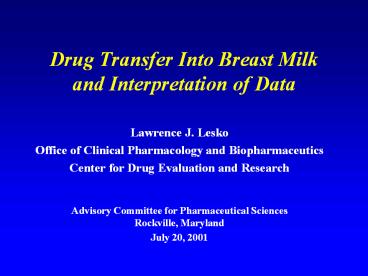Drug Transfer Into Breast Milk and Interpretation of Data - PowerPoint PPT Presentation
1 / 11
Title:
Drug Transfer Into Breast Milk and Interpretation of Data
Description:
... is the paucity of reliable and comprehensive studies of drugs in breast milk ... to include more complete information in product labels related to breast milk ... – PowerPoint PPT presentation
Number of Views:44
Avg rating:3.0/5.0
Title: Drug Transfer Into Breast Milk and Interpretation of Data
1
Drug Transfer Into Breast Milk and
Interpretation of Data
- Lawrence J. Lesko
- Office of Clinical Pharmacology and
Biopharmaceutics - Center for Drug Evaluation and ResearchAdvisory
Committee for Pharmaceutical SciencesRockville,
Maryland - July 20, 2001
2
(No Transcript)
3
Demographics 1998
- 61 million
- number of women between 15-44 yrs of age
- 4 million
- number of newborn infants
- 65
- fraction of infants who breastfeed
- 2.6 million
- number of potential recipients of unwanted drug
residues
4
Breast Milk or Formula Making the Right Choice
for Your Baby
RegulatedbyFDA
NoFDAGuidance
Human milk is made for human infants. It meets
all their specific needs. - FDA Consumer, Sept
1998
5
Medications in Breast-Feeding Mothers
BenefitsofMedicationforMother
Sources of Information internet resources, 11
consultations, periodicals
6
http//www.perinatology.com
All were rated Compatible with breast-feeding!
7
Medications in Breast-Feeding Mothers
BenefitsofMedicationforMother
Sources of Information internet resources, 11
consultations, periodicals
8
The dairy industry has a profound interest in
producing high quality products free of
antibiotic residues. Antibiotic residues in milk
are a food safety concern to FDAs Center for
Veterinary Medicine.- http//www.fda.gov/cvm
Antibiotics are widely used in veterinary
practice for therapeutic purposes. Screening is
often the first line of food safety monitoring
for the presence of these drugs in milk.- FDA
Veterinarian, Sept/Oct, 1997
9
Purpose of Discussion
- Our responsibility as a regulatory agency
- to identify and reduce the barriers related to
medications which keep women from initiating or
continuing to breastfeed their infants - major barrier is the paucity of reliable and
comprehensive studies of drugs in breast milk - well-designed breast-milk studies in NDAs are
rare
10
Purpose of Discussion (Cont.)
- To encourage improvements in the science of drug
development - to provide data on the transfer of medications
into breast milk and the potential risk to
infants - to include more complete information in product
labels related to breast milk - to empower woman, and their physicians, to make
rational choices about benefits and risks
11
Dr. Arzu Selen - background, issues and
questions Dr. Shinya Ito - assessing drug
transfer into breast milk Dr. Pat McNamara -
clinical methods and issues related drug
transfer into milk































